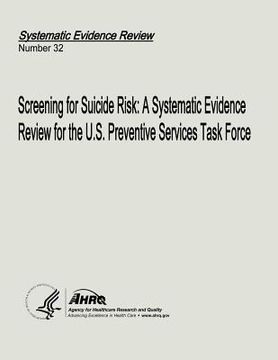Screening for Suicide Risk: A Systematic Evidence Review for the U.S. Preventive Services Task Force: Systematic Evidence Review Number 32 (en Inglés)
Reseña del libro "Screening for Suicide Risk: A Systematic Evidence Review for the U.S. Preventive Services Task Force: Systematic Evidence Review Number 32 (en Inglés)"
Suicide is a major public health problem in the U.S. It is the seventh leading cause of years of potential life lost, with a total similar to years lost from perinatal deaths and greater than years lost from diabetes, liver disease, and HIV. Annually, approximately 500,000 individuals require emergency room treatment in US medical centers as the result of attempted suicide. The public health significance of this problem is underscored by The Surgeon General's Call to Action to Prevent Suicide, which proposed completion of a National Strategy to Prevent Suicide. The risk of completed suicide is highest for individuals 65 years and older; white men over 85 years have an especially high rate (59/100,000). It is also a major factor in adolescent mortality; suicide was the third leading cause of death among persons 15 to 24 years of age, following unintentional injuries and homicide. Risk factors for all age groups are similar, although particular clinical risk factors are notable for younger populations. The strongest risk factors for attempted suicide in adults are mood disorders and comorbid substance use disorders. The strongest risk factors for attempted suicide in youth include mood disorders and comorbid substance use disorders, but they also involve aggressive or disruptive behaviors and history of physical and sexual abuse. In general, hopelessness and a history of previous suicide attempts are strong prospective risk factors for a suicide attempt. Suicide completion is closely related to psychiatric illness as well. More than 90% of those with completed suicide have a diagnosable psychiatric illness at the time of death, usually depression, alcohol abuse, or both. Although the risk factors have been identified and the public health significance of suicide and attempted suicide are clear, the clinical management of suicide risk is complicated. Suicide is a rare event. It has a low prevalence in the general population (0.01%) and, despite a 10-fold increase in adults with depression, most depressed patients (99.9%) do not commit suicide. As a result, many clinical trials on the management of suicide risk have focused on patients at high risk for suicide, such as those with a history of deliberate self-harm (DSH). DSH, which is understood as intentionally initiated acts of self-harm with nonfatal outcome (including self-poisoning and self-injury), encompasses terms such as attempted suicide and parasuicide. DSH is not synonymous with attempted suicide-attempted suicide, understood as a self-initiated act with the intent of ending one's own life, is but a single example of DSH. Still, DSH is a recurrent behavior with important long-term risks. Between 15% and 23% of patients who are seen for DSH will be seen for treatment of a subsequent episode within 1 year, with a high risk of repeat DSH in the weeks following an episode. Identification of DSH is quite relevant to primary care practice: two-thirds of patients who deliberately harm themselves visit their general practitioner within 12 weeks of the episode. Patients with borderline personality disorder are at increased risk of DSH, with groups form psychiatric and primary care settings having similar self-harm profiles. Key Questions for Screening for Suicide Risk include: 1 Does screening for suicide risk in primary care settings result in decreased attempts and/or decreased mortality? 2 Can a screening test reliably detect suicide risk in primary care populations? 3 Main outcome: For those identified as being at risk, does treatment result in decreased suicide attempts and/or decreased mortality from suicide? 4 Intermediate outcome: For those identified as being at risk, does treatment result in decreased suicidal ideation, decreased depressive severity, decreased hopelessness, or improved level of functioning? 5 What are the harms of screening? 6 What are the costs of screening? 7 What are the harms of treatment? 8 What are the costs of treatment?

